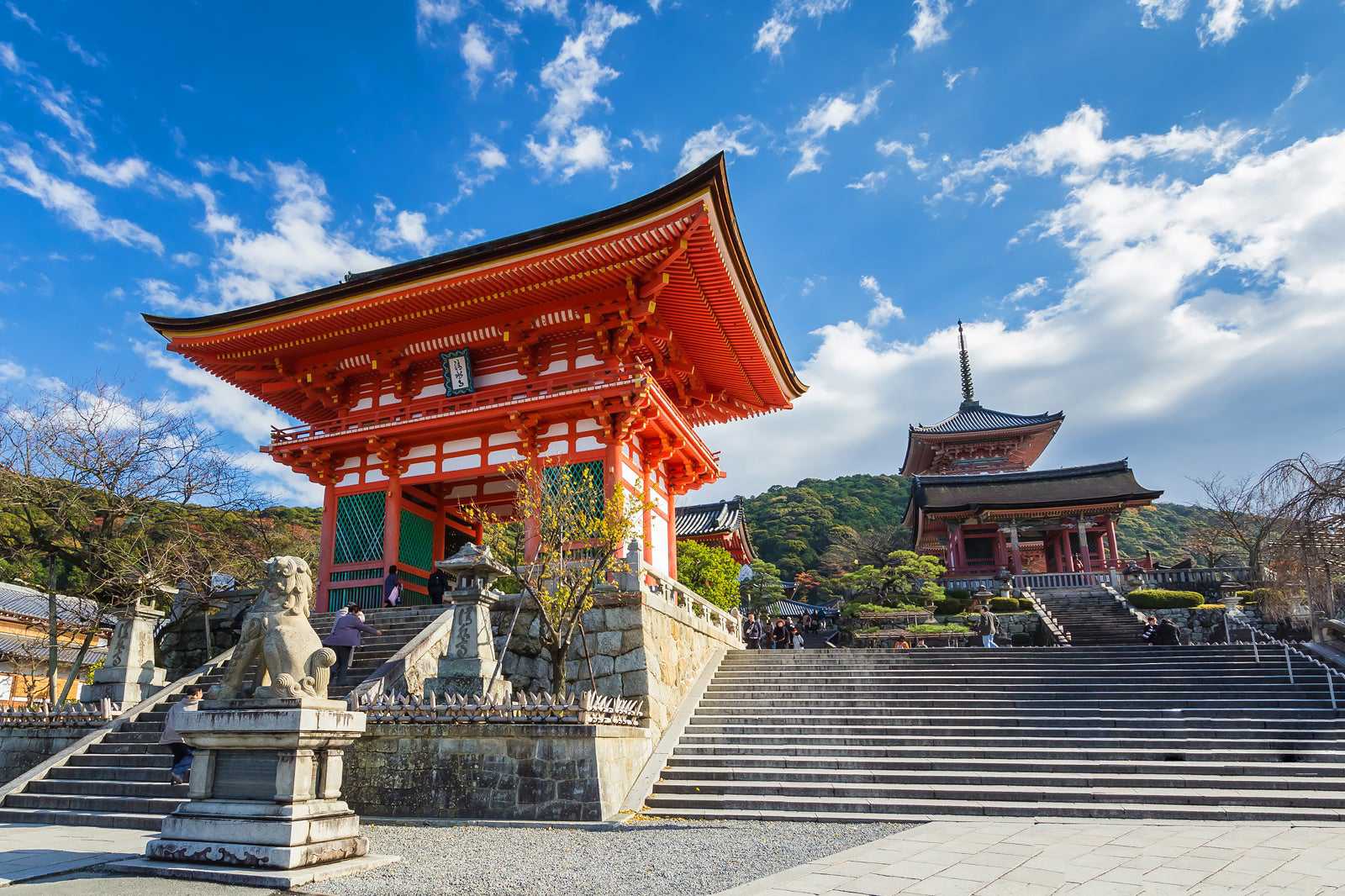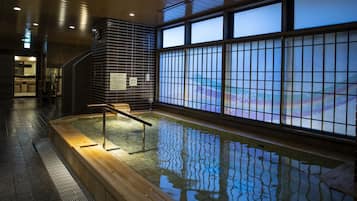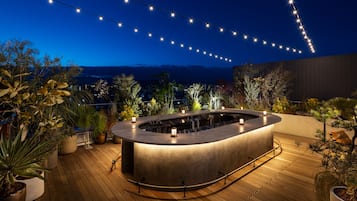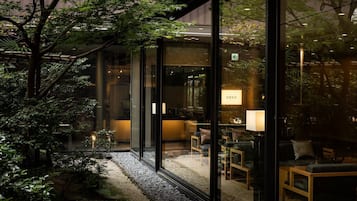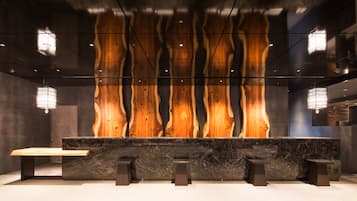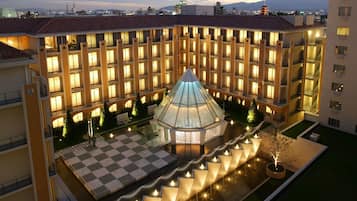Among the must-see temples and shrines in Kyoto, there's an incredible diversity in design and size. This variety reflects Kyoto's rich history of Buddhism and Shinto, Japan's ancient religion, which holds that everything has a spirit and should be respected.
During any walk around the ancient capital, you’re bound to come across a sacred site as the city has built up around them. It’s incredible how authentic and serene some of Kyoto’s best temples are, despite their location in the city centre. The list below contains what we believe are the very best temples and shrines in Kyoto.
- 1
Kiyomizu Temple
One of Japan's most celebrated temples
- Familier
- Historie
Les merVisiting Kiyomizu Temple (Kiyomizu-dera) in Kyoto’s wooded eastern hills is like travelling back in time. This 'Pure Water Temple' is a UNESCO World Heritage Site and one of Japan’s most celebrated temples. Kiyomizu Temple is best known for its 13-metre-high wooden platform that juts out from the main hall.
The platform affords visitors great views out over the numerous maple and cherry blossom trees below that burst into a bright sea of colour in spring and autumn. It also has panoramic views of Kyoto city centre in the distance. The main hall was built without the use of nails and houses the temple's primary object of worship: a small statue of the eleven faced, thousand-armed Kannon.
Beliggenhet: 1 Chome-294 Kiyomizu, Higashiyama Ward, Kyoto 605-0862, Japan
Åpent: Hours vary by season
Kart - 2
Kinkakuji (The Golden Pavilion)
Golden scenery
- Par
- Familier
- Fotografering
Les merKinkakuji Temple, or the 'Temple of the Golden Pavilion', is one of the most visited attractions of Kyoto. This Zen Buddhist shrine is a UNESCO World Heritage site and a breathtaking piece of architecture, surrounded by a Japanese style garden. Also known as Rokuonji or the Deer Garden Temple, Kinkakuji was built in 1397 as a retirement pavilion for Shogun Yoshimitsu Ashikaga (1358-1409).
Its 3 floors stand 12.8 metres high with the top 2 layers gilded in gold-leaf on Japanese lacquer, giving it such a unique appearance. Don’t miss the traditional tearoom within the temple grounds. Located in northern Kyoto, Kinkakuji can be accessed from Kyoto Station by direct Kyoto City Bus number 205 in about 40 minutes.
Beliggenhet: 1 Kinkakujicho, Kita Ward, Kyoto 603-8361, Japan
Åpent: Daily from 9 am to 5 pm
Telefonnummer: +81 (0)75-461-0013
Kart - 3
Fushimi Inari Shrine
An ascend through a thousand gates

- Par
- Familier
- Fotografering
Fushimi Inari is a Shinto shrine that boasts thousands of bright orange torii gates leading up to the sacred Mount Inari. The upkeep of the gates is sponsored by local businesses, and it is believed to keep these organisations financially prosperous. The shrine was built back in 711 and is dedicated to the fox (inari) which is believed to protect the annual harvests.
It takes around 2 hours to hike to the summit of the mountain. You can reach the shrine by taking the Keihan Line to Fushimi Inari Station.
Beliggenhet: 68 Fukakusa Yabunouchicho, Fushimi Ward, Kyoto 612-0882, Japan
Åpent: 24/7
Telefonnummer: +81 (0)75-641-7331
Kart - 4
Yasaka Shrine
A celebrated shrine hosting the Gion Festival

- Familier
Yasaka Shrine, a beautiful 5-storey pagoda in the east of Kyoto, is all that remains of a great temple that once stood here. Also called the Gion Shrine, it's the centrepiece of the annual Gion Festival.
Built in the 7th century, the enshrined Shinto deity Susanoo-no-Mikoto symbolises prosperity and protection against pestilence. A ritual when attending Yasaka Shrine is to write a prayer, wish or thought on a small piece of paper and tie it to the tree covered with tiny paper bows.
Beliggenhet: 625 Gionmachi Kitagawa, Higashiyama Ward, Kyoto 605-0073, Japan
Åpent: 24/7
Telefonnummer: +81 (0)75-561-6155
Kart - 5
Ryoanji Temple and rock garden
Mysteries of the rock garden

- Par
- Familier
- Fotografering
Ryoanji is famous for its karesansui rock garden more than the temple itself. Belonging to the austere Rinzai sect of Buddhism, the raked stone and rock garden is the epitome of Zen. Containing 15 rocks arranged into 3 groups of 3, 5 and 7, the garden is constructed so that only 14 rocks can be seen at any one moment. If you adjust your position another rock will appear only to find a different one newly hidden.
To avoid the crowds, try to get to Ryoanji early in the morning. To reach the temple, take the Keifuku Kitano line to Ryoanji-michi station.
Beliggenhet: 13 Ryoanji Goryonoshitacho, Ukyo Ward, Kyoto 616-8001, Japan
Åpent: March–November: daily from 8 am to 5 pm. December–February: daily from 8.30 am to 4.30 pm
Telefonnummer: +81 (0)75-463-2216
Kart - 6
Ginkakuji (The Silver Pavilion)
A touch of tranquillity in a beautifully sculpted sand garden

- Lave priser
- Fotografering
Ginkakuji (the Silver Pavilion) was originally constructed as a retreat for shogun Ashikaga Yoshimasa in 1460. Modelled after the resplendent Golden Pavillion (Kinkakuji), this temple was supposed to be coated in silver, but the shogun’s plans were thwarted by the Onin War. As it is, Ginkakuji may seem subdued compared to its golden counterpart, but it’s still a place of immense beauty, showcasing the harmonious blend of natural elements and human craftsmanship.
Within its walls the traditional arts of Noh theatre, flower arrangement, and the tea ceremony are taken to their heights. The meticulously maintained sand garden of Ginkakuji is one of the highlights of a visit.
Beliggenhet: 2 Ginkakujicho, Sakyo Ward, Kyoto 606-8402, Japan
Åpent: March–November: daily from 8.30 am to 5 pm. December–February: daily from 9 am to 4.30 pm
Telefonnummer: +81 (0)75-771-5725
Kart - 7
Daisen-in rock garden (Daitokuji Temple)
A journey through a stone tapestry of Japanese tradition and imagination

- Familier
- Fotografering
Located within the sprawling compound of Daitokuji, Daisen-in rock garden is an excellent example of the uniquely Japanese artistic and philosophical practice. See if you can identify the sea, the mountains and a boat represented in the rock formations, as many people claim. There are also animal faces and a waterfall depicted in the rock façade.
Built in 1513 during the Muromachi era, the garden is a depiction of a dry landscape and well worth a visit early before the tour buses arrive.
Beliggenhet: 54-1 Murasakino Daitokujicho, Kita Ward, Kyoto 603-8231, Japan
Åpent: March–November: daily from 9 am to 5 pm. December–February: daily from 9 am to 4.30 pm
Telefonnummer: +81 (0)75-491-8346
Kart - 8
Toji Temple
Shopping for antiques at the foot of the towering pagoda

- Familier
- Historie
- Fotografering
The 5-storey pagoda of Toji Temple is 57 metres tall and one of the tallest pagodas in Japan, as well as an iconic symbol of Kyoto. Last rebuilt in 1643 after a fire ravaged the temple, it was originally founded in the year 794. Toji Temple is associated with Kobo Daishi who established Shingon sect, and there's a plethora of tantric Buddhist artefacts housed within the temple halls.
The temple hosts a massive flea market on the 21st of each month where antiques are among the best buys. There is also a smaller antiques fair held the first Sunday of every month. Toji Temple is located in the south of Kyoto, around a 15-minute walk from Kyoto Station.
Beliggenhet: 1 Kujocho, Minami Ward, Kyoto 601-8473, Japan
Åpent: Hours vary by season
Telefonnummer: +81 (0)75-691-3325
Kart - 9
Koto-in (Daitokuji)
A hidden gem of Kyoto

- Familier
- Fotografering
Hidden away on the western side of Daitokuji, the small, reclusive Koto-in sub-temple deserves special mention for its priceless collection of national treasures from Japan and China. Enveloping the temple are mossy gardens that present a stunning spectacle during autumn with the vivid colours and dappled sunlight through the maple leaves. This spot is perfect for quiet contemplation, a peaceful respite or even a tranquil picnic amidst nature's splendour.
The temple grounds are a short walk west from Kitaoji subway station in northern Kyoto.
Beliggenhet: 73-1 Murasakino Daitokujicho, Kita Ward, Kyoto 603-8231, Japan
Åpent: Daily from 9 am to 4.30 pm
Telefonnummer: +81 (0)75-492-0068
Kart - 10
Kamigamo Jinja
The stage for the Aoi Matsuri festival

- Fotografering
Kamigamo Jinja, also known as Kamo Shrine, consists of 2 important Shinto shrines lying on opposite sides of the Kamo River. These include the Kamo-wakeikazuchi Shrine, located in Kyoto's Kita Ward, and the Kamo-mioya Shrine in Sakyo Ward. These shrines were built to prevent demons from entering the city. Today, they are recognised as part of the UNESCO World Heritage listed Historic Monuments of Ancient Kyoto.
Every year in May, these shrines host the Aoi Matsuri, which is the oldest among Kyoto's 3 famous festivals.
Beliggenhet: 339 Kamigamo Motoyama, Kita Ward, Kyoto 603-8047, Japan
Åpent: Daily from 8.30 am to 5 pm
Telefonnummer: +81 (0)75-781-0010
Kart - 11
Mibu Temple
The guardian of children

- Familier
- Historie
- Fotografering
Mibu Temple (Mibu-dera) is a revered site belonging to the Risshu sect of Buddhism. Built in 991, the temple honours Enmei Jizo Bosatsu, the guardian deity of children. With Children’s Days for boys and girls being 2 important national holidays, Mibu Temple is a sacred place believed to have the power to fend off evil spirits while ensuring prosperity in the future.
A bean scattering festival called Yakuyoke-setsubun-e is held here annually in February. Mibu Temple is a walking distance from Omiya station on the Hankyu line.
Beliggenhet: 31 Mibunaginomiyacho, Nakagyo Ward, Kyoto 604-8821, Japan
Åpent: Daily from 8 am to 4.30 pm
Telefonnummer: +81 (0)75-841-3381
Kart - 12
Honnoji Temple
Temple with a rich history

- Historie
Suicide and betrayal underscore the Honnoji Temple, belonging to the Nichiren sect of Buddhism. Here, infamous warlord Oda Nobunaga took his own life after being betrayed by his general Mitsuhide Akechi, and a monument to his sacrifice is located within the temple grounds.
The temple was built in 1415 and rebuilt in 1587 after being ravaged by fire. Honnoji Temple isn't as spectacular as some others in Kyoto, but it is very conveniently placed close to the main shopping district and Kyoto Shiyakusho Maeeki station.
Beliggenhet: 522 Shimohonnojimaecho, Nakagyo Ward, Kyoto 604-8091, Japan
Åpent: Daily from 9 am to 5 pm
Telefonnummer: +81 (0)75-231-5335
Kart - 13
Tofukuji Temple
Kyoto's top spot for autumn's vibrant colours

- Lave priser
- Familier
Tofukuji Temple is a Zen temple with a huge open temple complex and beautiful gardens. Every autumn the temple is crowded with tourists who come to admire the perfect autumnal colours of the Japanese maple trees in combination with traditional temple architecture. It's considered traditional to view them from the Tsutenkyo Bridge. The remarkable 22-metre-tall main gate is the largest of all Zen temples in Japan.
Most of the property in Tofukuji’s grounds is free of charge to enter but the garden and Tsutenkyo Bridge requires an admission fee. It's easy to reach the temple on the JR Nara Line or Keihan Line to Tofuku-ji Station.
Beliggenhet: 15 Chome-778 Honmachi, Higashiyama Ward, Kyoto 605-0981, Japan
Åpent: Hours vary by season
Telefonnummer: +81 (0)75-561-0087
Kart - 14
Heian-jingu
A beautiful shrine hosting the Jidai Matsuri festival

- Familier
- Fotografering
Heian-jingu, also known as the Heian Shrine, proudly boasts Japan’s largest torii temple gates, which stand as an inviting entrance to this remarkable site. This Shrine serves as an impressive ¾ scale model of the Kyoto Imperial Palace, and it's an essential part of the city's cultural and historical fabric. Built in 1895, the shrine was established to commemorate the 1,100th anniversary of the founding of Heiankyo, now named Kyoto.
Heian-jingu is also the annual host of the Jidai Matsuri festival, one of Kyoto’s most significant cultural events.
Beliggenhet: 97 Okazaki Nishitennocho, Sakyo Ward, Kyoto 606-8341, Japan
Åpent: Daily from 6 am to 6 pm
Telefonnummer: +81 (0)75-761-0221
Kart - 15
Daitokuji
A complex of several temples, Japanese gardens and rock gardens

- Par
- Familier
- Fotografering
Daitokuji, a quintessential Zen Buddhist temple, is a grand spectacle that houses 4 exquisitely maintained Japanese gardens, meditative rock gardens and some of Japan's most ancient and grandest temples. Dating back to the 14th century, Daitokuji's high walls encompass many large temples and sub-temples, each bearing its own unique historical significance. The temple's scale is truly magnificent, reflecting the richness of Japan's religious culture and history.
To visit this captivating site, simply take the Karasuma subway line to Kitaoji station.
Beliggenhet: 53 Murasakino Daitokujicho, Kita Ward, Kyoto 603-8231, Japan
Telefonnummer: +81 (0)75-491-0019
Kart - 16
Matsuo-taisha
One of the oldest Shinto shrines in Kyoto

- Familier
- Fotografering
Matsuo-taisha is one of the oldest Shinto shrines in Kyoto, dating back to around 701, and is home to a natural spring that is believed to have blessed water. Local sake makers and miso producers frequent the shrine to pray that their products are blessed and thus successful. The shrine serves kinpaku miki, a special blessed sake filled with gold leaf, during the New Year festival.
The temple is a walking distance from Matsuo-taisha station on the Hankyu Arashiyama line.
Beliggenhet: 3 Arashiyama-miyamachi, Nishikyo Ward, Kyoto 616-0024, Japan
Telefonnummer: +81 (0)75-871-5016
Kart - 17
Kitano Tenmangu Shrine
A symphony of plum blossoms

- Familier
- Fotografering
Kitano Tenmangu Shrine is a Shinto shrine built in 947 to conciliate the spirit of Sugawara no Michizane, a famous scholar, poet and official. The temple grounds are very scenic, overflowing with Michizane’s favourite red and white plum blossom trees.
Every year on 25th February the Plum Blossom Festival is held here to commemorate Michizane’s death. It's a great chance for you to experience the rare sight of geiko and maiko hosting open-air tea ceremonies.
Beliggenhet: Bakurocho, Kamigyo Ward, Kyoto 602-8386, Japan
Åpent: Daily from 7 am to 5 pm
Telefonnummer: +81 (0)75-461-0005
Kart - 18
Chion-in Temple
Where an ancient bell heralds a new beginning

- Historie
- Fotografering
Built to proclaim the superiority of the Jodo sect of Buddhism, Chion-in Temple features the colossal Sanmon gate, the most imposing of any Japanese religious site. The temple is located where Honen, the Jodo sect’s founder, initiated his teachings and later fasted himself to death in 1212. Like many Kyoto temples, Chion-in has been repeatedly devastated by fires and earthquakes. The oldest surviving buildings are the Hon-do (Main Hall), rebuilt in 1633, and the Daihojo (Abbots’ quarters), rebuilt in 1639.
A massive bell housed in the main hall is rung 108 times during New Year celebrations, symbolising the cleansing of the previous year's excesses. The temple is north of Maruyama Park and close to the Gion area of Kyoto.
Beliggenhet: 400 Rinkacho, Higashiyama Ward, Kyoto 605-8686, Japan
Åpent: Hours vary by season
Telefonnummer: +81 (0)75-531-2111
Kart - 19
Higashi Honganji Temple
A serene sanctuary in the heart of Kyoto

- Lave priser
- Familier
- Fotografering
Higashi Honganji Temple (The Eastern Temple of the Original Vow) covers a large area near Kyoto Station. Within the complex, cavernous buildings demonstrate the might of the Tokugawa Shogunate. The large pigeon population in the central courtyard may well have annoyed him, though.
This temple is full of ornate buildings. Enter through the 28-metre-tall Founder’s Hall Gate for a feeling of grandeur. An interesting element of this temple is the long black rope, which was used during the reconstruction of the temple during the 19th century. The rope is completely made of female devotees’ hair.
Beliggenhet: Shimogyo Ward, 600-8505 Kyoto, Japan
Åpent: March–October: daily from 5.50 am to 5.30 pm. November–February: daily from 6.20 am to 4.30 pm
Telefonnummer: +81 (0)75-371-9181
Kart - 20
Seimei Shrine
A timeless sanctuary spanning over a thousand years

- Lave priser
- Familier
Seimei Shrine was commissioned by Emperor Ichijo in memory of Abe no Seimei, a spiritual adviser to emperors and the Heian government. The temple was built in 1007, on the site of Seimei's house following his death. It contains a famous well that is believed to have magical water.
The symbol of a pentacle is found in many areas of the temple, representing the 5 Chinese elements. At the rear of the temple there's a bridge that some claim is the gateway to the spiritual world.
Beliggenhet: 806 Seimeicho, Kamigyo Ward, Kyoto 602-8222, Japan
Åpent: Daily from 9 am to 5 pm
Telefonnummer: +81 (0)75-441-6460
Kart - 21
Nanzenji
A tranquil Zen temple amidst majestic mountains

- Historie
- Fotografering
Built during the mid-13th century, Nanzenji is one of the most important Buddhist temples in the world. Originally, Emperor Kameyama decreed Nanzenji a retirement villa but later converted it to a Zen temple which prospered until it was destroyed during 200 years of civil war.
Nestled at the foot of the Higashiyama mountains, and with a number of equally beautiful sub-temples all rebuilt over time, Nanzenji is the quintessential tranquil Zen temple despite its enormous size. To reach Nanzenji, take the subway to Keage Station.
Beliggenhet: 86 Nanzenji Fukuchicho, Sakyo Ward, Kyoto 606-8435, Japan
Åpent: March–November: daily from 8.40 am to 5 pm. December–February: daily from 8.40 am to 4.30 pm
Telefonnummer: +81 (0)75-771-0365
Kart - 22
Shodenji Temple
A tranquil temple with a dramatic past

- Lave priser
- Familier
- Historie
Drama is literally built into Shodenji Temple, tucked away at the foot of a hill. After suffering a shocking defeat in the Battle of Sekigahara, a group of soldiers committed mass suicide in Fushimi Castle. The temple's ceiling is crafted from the bloodstained floorboards of Fushimi Castle. Yet, the tranquillity of the temple compound defies the tragedy of its history.
Each year, Shodenji Temple participates in the Gozan Fire Festivals, an awe-inspiring spectacle where 5 of Kyoto’s mountainsides are set ablaze to spell out the phrase 'Wonderful Buddhist Law'.
Beliggenhet: 72 Nishigamo Kitachinjuancho, Kita Ward, Kyoto 603-8847, Japan
Åpent: Daily from 9 am to 5 pm
Telefonnummer: +81 (0)75-491-3259
KartFoto: Nullumayulife (CC BY 2.0) retusjert
- 23
Nishi Honganji Temple
Captivating artistry

- Familier
- Fotografering
Nishi Honganji Temple is a vast temple complex and the oldest of the 2 Honganji temples. It is now the headquarters of the prosperous Jodo Shin-shu sect of Buddhism.
While the temple is not entirely accessible to the public, visitors can admire the exquisite artistry within its 2 open halls, adorned with intricate carvings and beautiful paintings on paper screens and walls. These masterpieces are created by the Kano school of artists. Conveniently located, Nishi Honganji Temple can be found just a 10-minute walk north of Kyoto Station.
Beliggenhet: Honganji Monzencho, Shimogyo Ward, 600-8501 Kyoto, Japan
Åpent: Hours vary by season
Telefonnummer: +81 (0)75-371-5181
Kart - 24
Tenryuji Temple
The Temple of Heavenly Dragon

- Par
- Familier
- Fotografering
Tenryuji Temple is an important temple in the Rinzai sect of Buddhism and a UNESCO World Heritage Site. It’s colloquially known as the Temple of Heavenly Dragon because the founding abbot dreamed of a vanquished enemy, Emperor Go-Daigo, as a golden dragon rising from the nearby Oigawa river. Fearing ill fortune, shogun Ashikaga Taka had the temple erected in place of Go-Daigo’s favourite villa retreat.
Dating back to 1339, Tenryuji Temple has been destroyed by fire no less than 8 times. Present buildings were rebuilt in 1900. To reach the temple, take the JR San-in Main Line from Kyoto Station to Saga Station.
Beliggenhet: 68 Sagatenryuji Susukinobabacho, Ukyo Ward, 616-8385 Kyoto, Japan
Åpent: Daily from 8.30 am to 5 pm
Telefonnummer: +81 (0)75-881-1235
Kart
